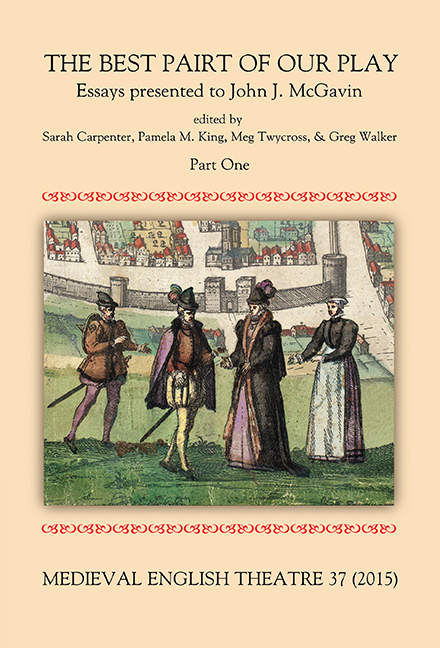Book contents
- Frontmatter
- Contents
- Epigraph
- Editorial
- In honorem John J. McGavin
- John J. McGavin: Bibliography
- The Places of Foolery: Robert Armin and fooling in Edinburgh
- George Bannatyne's ‘Sertane Mirry Interludis’, and Sir David Lyndsay's play
- The Linlithgow Interlude of 1540 and Lyndsay's Satire of the Thrie Estaitis
- Stage Directions in Lyndsay's Ane Satire of the Thrie Estaits
- The Dramatic Voice of William Dunbar
- How to Track a Bear in Southwark: a learning module
- The Digby Mary Magdalen in Performance: a merry peripeteia
- ‘Thus am I Rent on Rode’: taking apart the Towneley Crucifixion
- The Second Shepherds' Play: a play for the Christmas season
- ‘They did not come out of an Abbey in Lancashire’: Francis Douce and the manuscript of the Towneley Plays
- EDITORIAL BOARD (2015)
Stage Directions in Lyndsay's Ane Satire of the Thrie Estaits
Published online by Cambridge University Press: 05 March 2016
- Frontmatter
- Contents
- Epigraph
- Editorial
- In honorem John J. McGavin
- John J. McGavin: Bibliography
- The Places of Foolery: Robert Armin and fooling in Edinburgh
- George Bannatyne's ‘Sertane Mirry Interludis’, and Sir David Lyndsay's play
- The Linlithgow Interlude of 1540 and Lyndsay's Satire of the Thrie Estaitis
- Stage Directions in Lyndsay's Ane Satire of the Thrie Estaits
- The Dramatic Voice of William Dunbar
- How to Track a Bear in Southwark: a learning module
- The Digby Mary Magdalen in Performance: a merry peripeteia
- ‘Thus am I Rent on Rode’: taking apart the Towneley Crucifixion
- The Second Shepherds' Play: a play for the Christmas season
- ‘They did not come out of an Abbey in Lancashire’: Francis Douce and the manuscript of the Towneley Plays
- EDITORIAL BOARD (2015)
Summary
Textual Features
In reviewing the rich accumulation of stage directions in the two surviving texts of Lyndsay's Ane Satire of the Thrie Estaitis I should like to consider how they illuminate the purposes underlying the composition, performance, and publication of this work. These are not simple to describe for a variety of reasons, but the remarkable scope and quantity of directions may be revealing of emphasis and interpretation. When considering any set of stage directions, we need to take account of the ostensible purposes in composing them, which initially might be conceived as twofold. Firstly the author, or someone connected with a production, needs to prescribe details which are necessary for the enactment, or, in a complementary sense, the stage directions might be a record of what had actually been done onstage. The second aim might be to enable a reader not connected to live theatre to envisage a performance. For the Satire this might be peculiarly necessary because its great size makes a real life production a very rare undertaking. However, these objectives are not as distinct as they might appear, and they cannot be separated exclusively. Moreover, the directions may be the work of a variety of contributors to the final text: besides the author, there are those involved in staging, those engaged in creating a manuscript, and those working in a printing house. In addition the publication of a book may be an ideological achievement in itself, whatever the record of past performance, or the potential for future performance, it might contain. The directions reflect objectives which vary between diverse dramatic styles and themes. In interpreting the stage directions we may be looking in a number of different perspectives without necessarily reaching a holistic conclusion. In short the stage directions may embody valuable indications of differing objectives within the play deriving from both performance and publication.
The Satire is intriguing because the two surviving texts, the Bannatyne Manuscript and the quarto printed by Robert Charteris, are different in intention, even though they are intimately connected witnesses to the same play. Bannatyne's version is an extended selection of episodes in an anthology he created in 1568, …
- Type
- Chapter
- Information
- Medieval English Theatre 37The Best Pairt of our Play. Essays presented to John J. McGavin. Part I, pp. 57 - 72Publisher: Boydell & BrewerPrint publication year: 2015

